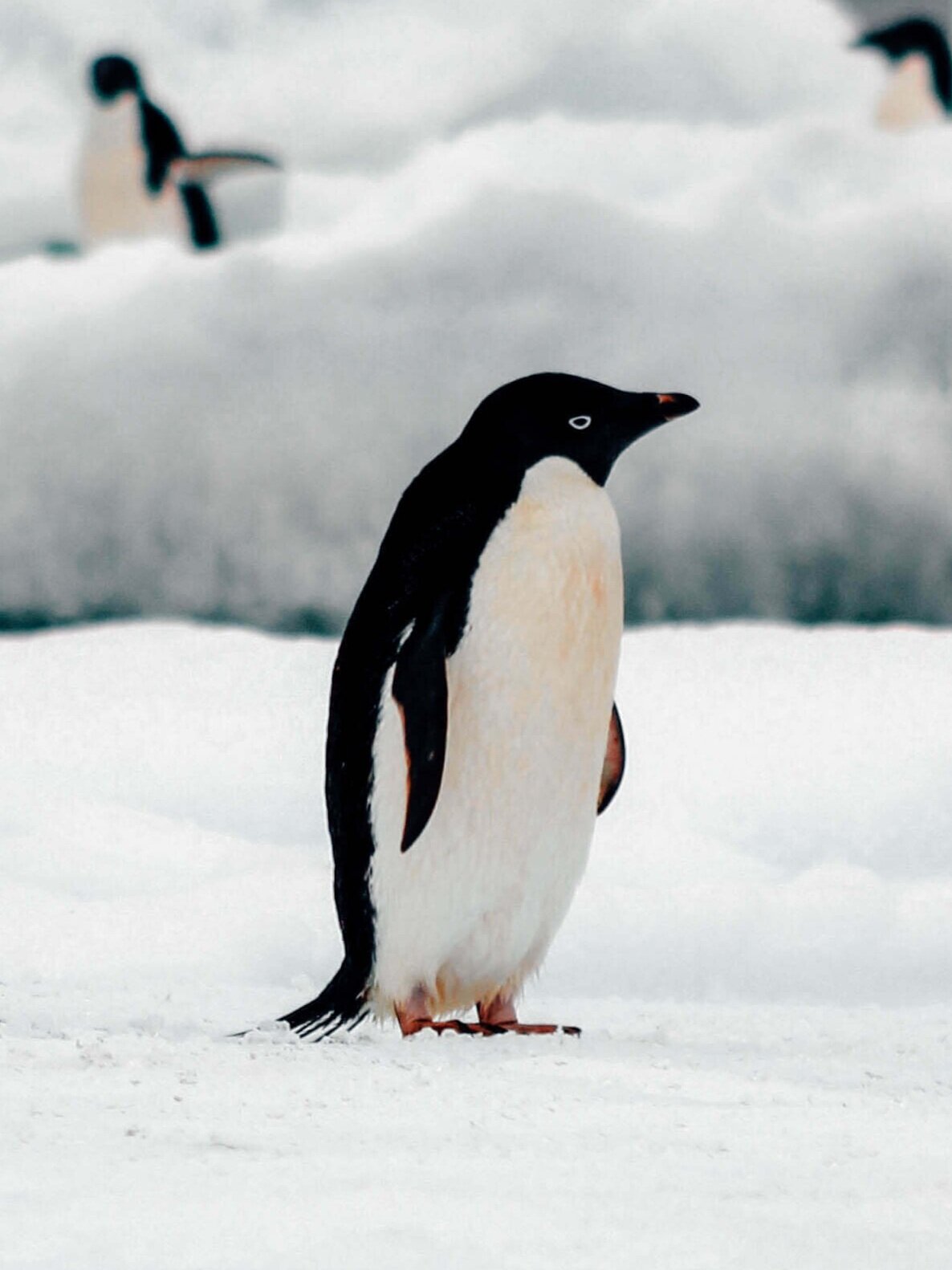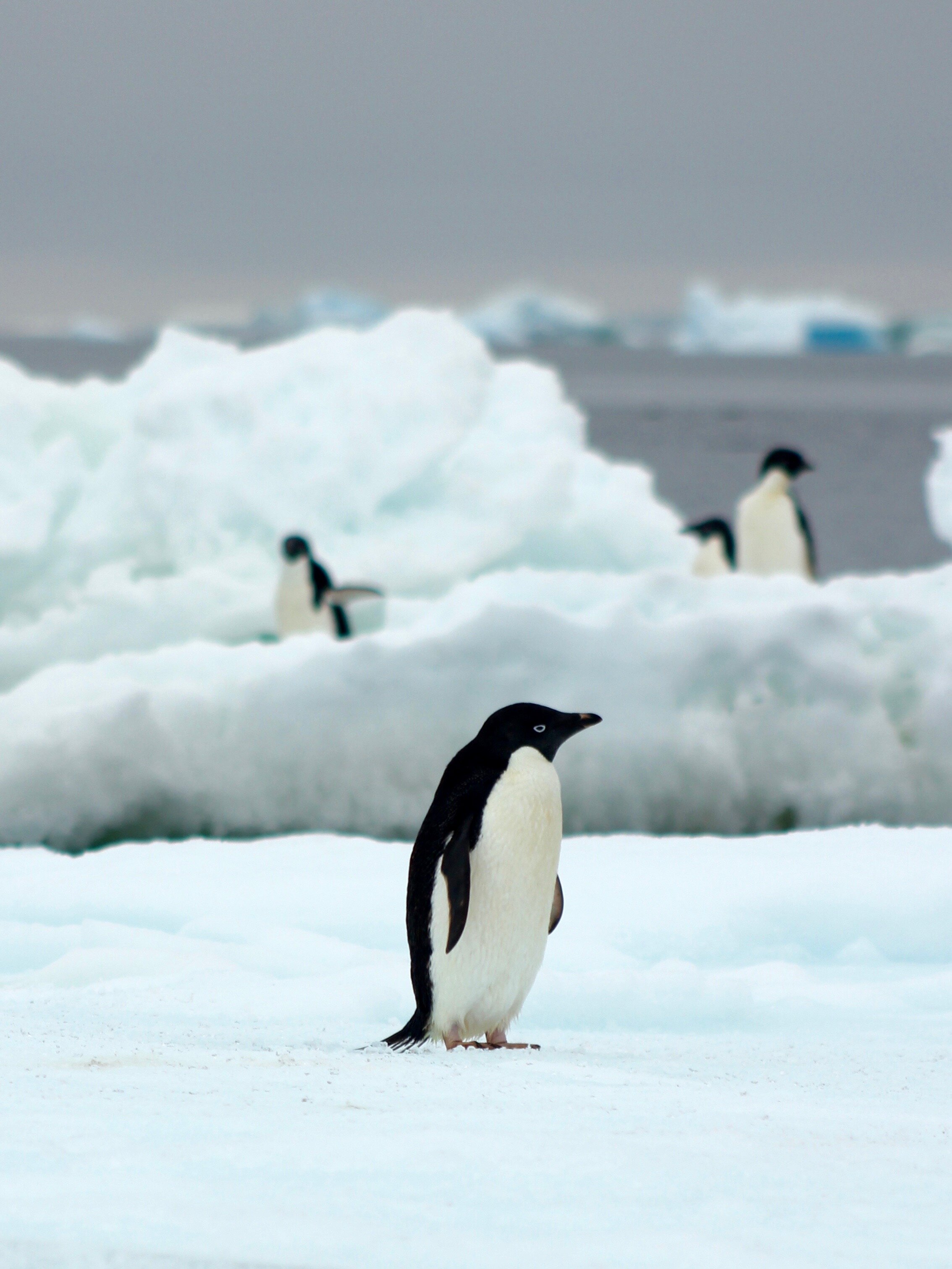Wildlife of the Antarctic Peninsula
The first time I saw a penguin in the wild was from very far away. through my porthole, it was nothing more than a minuscule black speck in a literal sea of whites and blues. For two days we had sailed toward Antarctica with nothing but crashing waves and a perpetual gray afternoon outside our windows. Seeing this dot of a penguin was like the light at the end of the tunnel - we had finally arrived in the most remote place in the world.
Aside from the remarkable (and remarkably chilly) landscape, the main draw of partaking in an Antarctic expedition is the abundance of wildlife. Penguins are, of course, the star of the show, but the opening acts are equally as impressive. While sailing the frigid waters you will spy seals napping on the ice, whales breaching the waves and birds riding the horizon. And no, there are no polar bears, you’ll have to head up north for those bad boys (if you’re looking for those, check out Field Report: Svalbard!)
This wildlife guide breaks down the main species found on the Antarctic Peninsula, that spit of land due south of South America. Whether you are eager to visit for yourself one day or are merely curious about the locals of Antarctica, this guide allows you to learn more about the wildlife encountered. All photos, unless otherwise noted, were taken on my expedition to Antarctica in January 2020, which you can read about in more depth in Journey to Antarctica.
Penguins
From South America to New Zealand you will find well-dressed waddlers, both big and small, roaming the land. While there are 17 species of penguin scattered across the southern hemisphere, three call the Antarctic Peninsula home. Generally speaking, these lovable flightless bird have similar characteristics across the board; a little aloof, an underdeveloped sense of gravity and a goofy nature. In addition to these charming traits, each species boasts remarkably distinct personality characteristics.
On a trip to the Antarctic Peninsula, you will meet the feisty Adelie, sweet Gentoo and saucy Chinstrap penguins.
Adelie
Averaging just two feet tall, Adelies are the smallest of the Antarctic penguins, but what they lack in height they make up for in attitude. These spunky little fellows fiercely take on predators far larger than themselves and are cheeky thieves within their own colonies.
Their playful attitude and unhinged curiosity make them extraordinarily fun to watch. If their boldness doesn’t give them away, their quintessential googley eye will (which makes them seem even sillier than they already are).
Gentoo
Gentoos are non-aggressive penguins that know how to keep their cool and effortlessly exude a calm demeanor. That said, they do have a killer trumpet-like call that will surely wake you up.
They generally prefer non-icy locales and like to just sit back and relax with their pals. They are known for their sweet and docile disposition, as well as for being tidy and clean (as far as penguins go). Also of note is that Gentoo chicks are the cutest, chubbiest, most perfect little baby penguins in the world.
Chinstrap
I won’t say that Chinstraps are mean, but they’re also not not mean. They are known for their saucy, somewhat aggressive nature, which is hard to deny since they like to pick fights and quarrel over rocks and women and other important penguin matters. They also have an ear-piercing screech that they aren’t afraid to use. And they do. Liberally.
I’m not painting a lovely picture of these guys, am I? I will say that they are good looking penguins (and don’t they know it).
other penguins
While the Peninsula is the most popular area to visit, various penguin species can be found all over the continent. On the Falkland Islands, a British Territory off the shores of Argentina, yellow-haired Rockhoppers and Macaroni penguins hop around. These two species are both more or less the class clowns of the penguin world. On the island of South Georgia, a wildlife mecca that takes four days to reach from Argentina, you will be surrounded by hundreds of thousands of King penguins, a regal species that lives up to its name. At three feet tall, they closely resemble Emperors, but are a bit smaller.
Which brings me to the ultimate, and arguably most beloved, penguin: the Emperor. When thinking of these tuxedoed animals, you likely have an Emperor penguin in mind. They are the center of most documentaries, such as March of the Penguins as narrated by one Morgan Freeman. Unfortunately, Emperor penguins are quite elusive and, in my opinion, wildly masochistic. Most who visit Antarctica will never see one. In fact, many guides who have worked in Antarctica for years have never laid eyes on one. For the majority of the year, Emperor penguins spend their time in the middle-of-nowhere eastern Antarctica in the dead of winter huddling against sub-freezing winds death-defying temperatures. You can see them briefly near the Peninsula in November, when they breed, but they are most commonly seen in the Ross Sea, an area that is four days of sailing from Australia and New Zealand.
Seals
Of the six seal species in Antarctica, three are found on the Peninsula: Weddell, Crabeater and Leopard seals, only one of which has a mildly appropriate name. I’m not the biggest seal fan out there but I do appreciate their extraordinary talent for naps and their pups are sure cute. They also move like floppy land snakes on the ice, which is hard not to smile at.
Weddell seals
With their bulky bodies and tiny flippers, Weddell Seals are basically the T-Rex of Antarctica. Their friendly disposition and ability to snooze with a smile also makes them easy to love.
These balls of blubber are found all over the region but are most prevalent on the Antarctic coastlines (including the Weddell Sea). Since they are non-migratory, they hang out on or under the ice year round.
During winter, they find food with their whiskers and poke breathing holes in the ice. They can also dive for an impressive 80 minutes and even mate underwater. Resilient chaps, these ones.
Crabeater seals
If named for what they ate they would be known as Krilleaters, not Crabeaters, seeing as they do not consume any crab and their diet is 95% krill. But I digress.
These gentle giants are plentiful in number. In fact, they take the cake as the most abundant large mammal on earth. Which, I have concluded, means they take mating season very seriously.
Many Crabeaters have pink scars on their bodies from being attacked by the ferocious Leopard Seal. When not dodging their seal-eating cousins, they are very social and usually found napping on the ice.
Leopard seals
Prehistoric-looking Leopard Seals are evil penguin-eating monsters (I know, “circle of life,” but my choice in description still stands). Aggressive by nature and only topped on the Antarctic food chain by Orcas, Leopard Seals are not to be underestimated. Not only do they eat penguins, they also eat other seals.
They are largely solitary - and also just plain large - and have an absolutely terrifying set of chompers. Their name comes from the black spots that someone at some point in time associated with leopard fur and that sealed the deal on the name.
Birds
Bless the ornithology expedition guides for birds are given the reputation as boring. Are they a little less exciting? Sure. But they are still important and can have their interesting moments. For the sake of this guide (and my general lack of bird knowledge), I have kindly organized the birds into a “Nice” and “Naughty” list utilizing the utmost bias. More appropriate names have also been provided, also utilizing extreme bias.
Nice List
Neutral Sheathbills, Uninteresting-Fulmars, Fancy-Looking Snow Petrels, Non-Threatening Tiny Antarctic Tern, Funky-Looking Cormorants
Naughty List
Giant Penguin-Eating Petrels, Scavenging Skuas
And I apologize because that’s all I have to say about birds.
Whales
Is there an animal more impressive than the whale? It’s debatable, but I think not. Mighty but agile, prehistoric and bigger than buses, whales are truly majestic. Several species migrate to the frigid waters of Antarctica though there are eight or so types that you are likely to encounter near the Peninsula. Most popular are Minkes and Humpbacks, though Orcas are also common, albeit rarer to spot.
You may also spy Fin, Sei, Right and Sperm whales in the waters, though these species had been so heavily poached during the height of the commercial whaling era that they are each highly vulnerable and nearly extinct.
Blue Whale
Far more elusive but perhaps most impressive are the solitary Blue whales, the largest creature on Earth. These behemoths are bigger than dinosaurs, have hearts the size of sedans and are nearly 100 feet long. Like many whales, it survives on krill and plankton, a diet that never ceases to amaze me. It’s like a human eating microscopic crumbs for every meal (no thank you). Then again, they eat about 3 tons of krill a day, so that’d be a lot of crumbs…
Humpback whale
What’s not to love about these guys? Humpbacks are easy to recognize due to their large fins and textured blubber, which is actually a mixture of knobby hair particles and a ton of barnacles that they offer a free ride to (see, they’re even selfless!). Perhaps most notable is their acrobatic talent, which they are more than happy to show off. They effortlessly propel their 70,000 pound bodies out of the water and into the air, arching into a flip as gracefully as a gymnast before splashing back in the waves. While they are friendly, they are often solitary unless feeding with others (me too).
Orca (“Killer”) Whale
Is it a whale? Is it a dolphin? Is it a killer? All of the above! Orcas are spread worldwide but there is a substantial population in Antarctica, although some leave in winter in search of warmth (who can blame them?). Utilizing their powerful hunting skills, they subsist on basically anything they can get their fins on; seals, penguins, squid, walrus and even other whales. As social animals, they are typically spotted in pods that can be anywhere from five to one hundred whales strong, which - fun fact! - follow a female’s lead.
Minke Whale
For being the “smallest” whale (10 tons), Minkes have mighty loud vocalizations - think the same decibel level of jets taking off. For their size, they also have an appropriately cute name, which is pronounced mink-kee. These lone hunters (of fish and krill) often head to warmer waters in wintertime but grace the waters of Antarctica in the summer.














